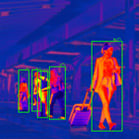Redefining business processes to move towards a smarter and more competitive future.
Artificial Intelligence (AI) is not just a passing trend, but a transformative tool that profoundly reshapes how business operates and competes. Those that adopt effective AI strategies enhance their efficiency and profitability and position themselves better to meet the demands of an increasingly digital and demanding consumer.
The strategic integration of Artificial Intelligence into business operations promotes significant benefits, driving innovation and enhancing customer orientation. AI accelerates business transformation by optimizing both basic processes and complex situations. Its ongoing evolution continues to revolutionize the world, improving efficiency and becoming an organization's fundamental ally. As its utility and practical models expand, its potential to transform business systems and tools grows. However, the growth of these technologies also raises questions about their potential positive and negative impacts on daily activities.

Addressing 5 classic myths about the application of AI
With the rise of Artificial Intelligence, user speculations have created myths about its use, which AI model providers and software manufacturers supporting this technology have clarified many uncertainties about:
- Will Artificial Intelligence replace humans in everyday activities?
No, AI-based solutions aim to optimize resources and deliver solutions more quickly, but they require a human to confirm or validate the responses obtained based on the given instructions and provide their expert opinion or approval.
- Will Artificial Intelligence use my personal or business data to feed its models?
No, all service providers state in their responsibility agreements that data entered as instructions will not be used to improve or optimize current models.
- Do responses or content generated by Artificial Intelligence have copyrights?
In the terms and conditions of the use of various tools, it is mentioned that the owner of the copyright to AI-generated responses is the same user who submitted the instruction, especially creating documents, images, and videos.
- What constitutes responsible use of AI?
Although some tools have safeguards to prevent misuse, the responsibility for what Artificial Intelligence may create lies with the user.
- What should I consider if I create a customized solution for my organization based on a provider's model?
You should consider classification, categorization, levels of information privileges, end users, and the focus on the AI's objectives, among other factors, to build a secure and effective solution.
Delving into the technologies and services available to accelerate business transformation with AI
Large Language Models like the LLM - Large Language Model.
Artificial Intelligence begins with these questions: How do they know so much? How can they give me a variety of answers?
Large language models are advanced neural network structures that process large amounts of text data, which must be trained with a large volume of information to "understand" various topics. By understanding language, its writing styles, and the organization of possible instructions received by the system, also called "Prompts," the goal is to understand and generate responses in natural language. This makes conversations with these kinds of tools more natural and effective. Therefore, LLMs are used in chatbots, virtual assistants, automatic translation, content creation, and more. These models enhance many of the tools available in the market.
Learn more about ValerIA Here:
The new path to productivity: Available solutions that empower the business with AI
Software providers have adapted several tools to enable the use of Artificial Intelligence to increase productivity, support teams for effectiveness, alleviate operational burdens and generate complex analyses, among many other possibilities.
One particular case is Microsoft, which, using resources developed jointly with OpenAI, has implemented an AI called COPILOT. It has been named this way because, as an assistant or co-pilot, it supports activities that can be carried out with innovative tools.
.jpg?width=1920&height=960&name=2395%20(1).jpg)
Microsoft Copilot encompasses 2 major functionalities that operate across solutions and services:
- EMBEDDED COPILOT
In applications and systems like Microsoft 365, Microsoft Power Platform, Microsoft Azure, and Microsoft Fabric, among others.
This means that office solutions used daily by all companies, such as creating and analyzing reports in Excel, creating presentations in PowerPoint, managing agendas, teams, chatbots, meetings, note-taking, identifying key elements in Teams, drafting documents, emails, endorsing the possibilities of optimizing resources being supported by AI through the Copilot solution, which is at hand and easy to implement by taking them to higher levels to support the rapid creation of automation flows and applications in the Power Platform, up to the code review and suggestions for optimizing resources and facilitating development team management if required.
- CUSTOMIZABLE COPILOT
Which can be built under the requirements, needs, and customizations that each company seeks, thanks to Copilot Studio, a tool that was previously in the Power Platform suite under the name Virtual Agents (used for low-code creation of chatbots), and which has now been enhanced with Artificial Intelligence for creating models and virtual assistants based on user needs.
By integrating with Microsoft solutions, they become tools of great utility and performance. The main advantage these copilots have is the improvement of human interaction and greater response effectiveness.

A look at 5 examples of AI application in business processes
- Automation and Operational Efficiency
Process automation enables efficient management of repetitive, rule-based tasks that previously required significant time and resources, allowing employees to focus on higher-value tasks, thereby improving the precision and consistency of operations.
- Advanced Data Analytics
The ability to rapidly analyze large volumes of data is transforming business decision-making. Through advanced machine learning algorithms and natural language processing, companies can extract meaningful insights, identify patterns and trends, forecast outcomes, and optimize business strategies.
- Customer Experience Personalization
AI enables companies to offer more personalized and relevant interactions, from product recommendations to customer service through intelligent chatbots. It enhances satisfaction by adapting to individual preferences and providing quick and accurate responses.
- Security and Risk Management
AI systems can quickly detect and respond to cyber threats, identify suspicious behaviors, and prevent fraud. This is critical in an environment where data protection is a priority for businesses and their customers.
- Innovation and Product Development
AI accelerates innovation processes, enhancing accuracy from design to production, optimizing development cycles, and anticipating market demand more precisely. This helps businesses remain agile and competitive.
In today's business landscape, Artificial Intelligence (AI) has evolved from a futuristic technology to become a tangible and strategic driver of change. From automating routine tasks to optimizing complex decisions, AI is revolutionizing how companies operate and compete in a globalized and dynamic market. As such, it is being used to transform business processes and positively impact organizations, focusing on intelligent automation to go beyond operational efficiency and maintain scalable personalization towards security and regulatory compliance standards.
Strategically adopting AI not only enhances operational efficiency and reduces costs but also drives innovation and enhances business responsiveness to tackle current market challenges. Moreover, it enables businesses to capitalize on emerging opportunities, thereby improving productivity, profitability and enhancing the customer experience in an increasingly advanced and modern business world.
Transform with Avvale
At Avvale, we are open to starting this conversation to help companies adopt Artificial Intelligence and transform their business operations towards efficiency and continuous innovation by redefining their business processes to move towards a smarter and more competitive future.
👉 Are you ready to lead your company down the new path of productivity with solutions that will enhance your business by adopting Artificial Intelligence?








.jpg?width=1920&height=960&name=2395%20(1).jpg)
